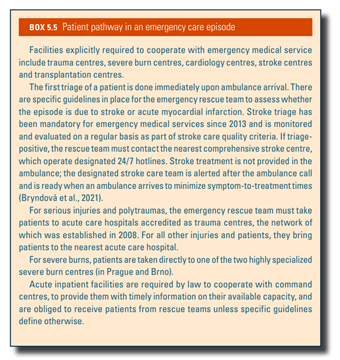-
11 July 2025 | Country Update
Amendment of the Act on Health Services: Enhancing emergency care and patient rights, and reducing bureaucracy
5.5. Urgent and emergency care
Emergency care comprises urgent medical care provided to patients with life-threatening conditions (sudden deterioration of health status or acute pain). According to the defining law, a patient should receive emergency care within 20 minutes after notification (Act no. 374/2011 Coll.). The emergency care network in Czechia consists of command centres, operational rescue service units, a rendezvous system and air emergency medical services. The network is part of the nationwide integrated rescue system, along with fire brigades and the police. Emergency service provision is guaranteed by the state and paid for via regional budgets and HIFs. Emergency service providers are public budgetary organizations directly under the regional authorities. The few private emergency services providers in Czechia operate based on contracts with regional emergency service providers.
Both the standard emergency number for Czechia (155) and the European emergency number (112) connect callers to triage personnel in command centres. In addition, the mobile application Záchranka connects users to the nearest dispatcher based on given GPS location in Czechia, Austria and Hungary, and also to mountain rescue services in Slovakia. In 2021, there were 319 emergency units that were staffed with a total of 6672 FTEs in Czechia, of which 598 (9%) were physicians, 2008 (30%) were drivers and the rest were nurses and paramedics (ZZS ČR, 2022a). In the same year there were a total of 1 164 811 outbound activities, increasing by more than 50% from 2009 (ZZS ČR, 2022b). Paramedics complete a special training course. Rescue teams have either two or three members as follows:
- a paramedic and a nurse, or two paramedics (general rescue team);
- a paramedic, a nurse and a physician, or two paramedics and a physician (medical rescue team); or
- a paramedic and a physician (rendezvous team).
In 2021, and when measured by numbers of patients treated, almost 80% of outbound activities were handled by teams headed by a paramedic, 6% by teams headed by a physician and the rest handled by a rendezvous system. The rendezvous system encompasses two tiers: the first is a small vehicle (not equipped for patient transport) with a paramedic driving a physician, while the second consists of a fully equipped ambulance, able to transport patients, with the general rescue team. In the rendezvous system, two separate units are sent to the scene of an accident or emergency to provide aid; the advantage of this being that the physician is available for another emergency after sending the patient to the hospital with the general rescue team.
The air emergency medical service (Letecká záchranná služba) is located at 10 stations scattered across the country and provides services throughout Czechia and border areas. The 10 helicopters in use are provided by private organizations (based on contracts with MZČR) or by the military. Crew assignments, equipment and dispatch are coordinated by rescue operation command centres.
For non-life-threatening situations outside standard physician and outpatient specialist hours, patients can seek out-of-hours outpatient care, usually located within hospitals (where the remaining user fee previously described applies if the visit does not lead to immediate hospitalization), and regions have been required to coordinate this care among regional hospitals since 2020.
Box5.5 provides a patient pathway in an emergency care episode in Czechia.
Box5.5
A major change is the transfer of responsibility for organizing emergency services (pohotovostní služby) from regions to health insurance funds, which is expected to improve equitable access by leveraging insurers’ greater capacity.
The reform also bolsters patient rights and protection by:
- introducing hospital ombudsmen to handle complaints directly within facilities,
- strengthening protections for patients at risk of domestic or sexual violence, and
- strengthening the right to transparent information about the cost of healthcare services and significantly tightening penalties for illegal fees charged by doctors.
The amendment also establishes centres for comprehensive care for children with long-term health conditions. These centres will provide coordinated, multidisciplinary care to improve the quality of life for paediatric patients and help families navigate the healthcare system more easily.

